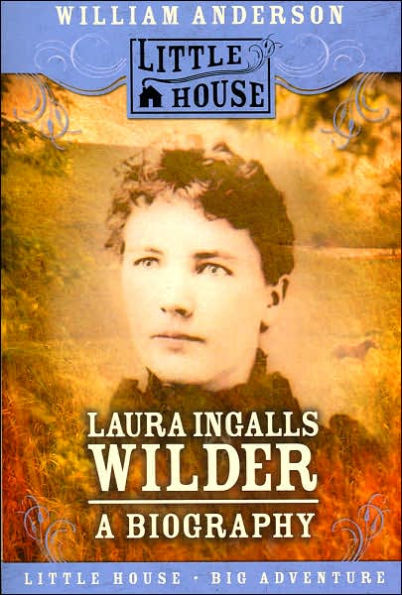Read an Excerpt
Chapter OneA Pioneer Family
When Laura Ingalls was born in the woods in the state of Wisconsin, the land there was still raw and wild. The region was called "The Big Woods" because the forests stretched out for miles toward the bluffs of the Mississippi River to the west and on to Lake Superior to the north. Panthers and bears and deer roamed through the brush, and the big trees grew thick enough to blot out the sky overhead. Only the coming of a few trappers, hunters and farmers made the countryside seem slightly civilized. Still, miles often separated one frontier farm from the next.
Laura's parents, Charles and Caroline Ingalls, were Wisconsin pioneers. Her father, Charles Philip Ingalls, was born near Cuba, New York, in 1836. His boyhood was spent with a big family of eight brothers and sisters moving west with their parents, Lansford and Laura Ingalls. When Charles was nine, the family lived in the state of Illinois, just west of a growing frontier town called Chicago. Then they traveled north into Wisconsin, settling close to the Oconomowoc River, near the village of Concord.
Working with his father and his brothers on their family farm, Charles grew strong and straight and keen in the ways of the woods. He learned to be a shrewd frontiersman, meeting new difficulties and hardships with spirit and skill. Making the new land produce enough food for the Ingalls family was a challenge that Charles, his brothers and their father conquered together. When work was slack on their own place, the Ingalls boys worked for other farmers. They brought home the money they earned, to help buy shoes and schoolbooks for the younger brothersand sisters. Peter and Charles were the oldest; then came Lydia, Polly, Lansford James, Laura Ladocia, Hiram, George and Ruby.
For Charles Ingalls, attending the neighborhood schools was possible only when he could be spared from farm work. But he quickly realized the importance of reading and writing and all knowledge. He learned to write his name, Charles P. Ingalls, with a flourish, and he became a good speller. His family were all good storytellers, but Charles also liked to read. When he was seventeen, a hard-earned $1.25 left his pocket to buy a scroll-covered two-volume set of books called The Life of Napoleon.
Growing up in the Wisconsin woods along the Oconomowoc River, Charles not only learned to be a skilled carpenter, trapper, woodsman, hunter and farmer. He also learned to sing and dance and play songs and hymns on a honey-colored fiddle. No one in the family remembered how Charles Ingalls first acquired a violin; perhaps he bought it from a traveling peddler or traded for it with a neighbor. By the time he was a teenager, Charles and his fiddle had started a lifetime of making music together.
The Ingalls family sat around the fireplace through long winter evenings listening to the music Charles fiddled, and soon the neighbors knew where they could find rollicking, foot-tapping tunes. Charles Ingalls was so jolly and so bold a fiddler he was a popular addition to the neighborhood frolics. The Ingalls children attended spelling schools, hot-maple-sugar parties, sleigh rides and corn-husking socials. But the dances were the most exciting events of all.
At harvest parties or wedding dances or house buildings, Charles Ingalls was an important guest. With other fiddlers and banjo players, or alone on his own violin, he'd play "The Irish Washerwoman," "Buffalo Gals," "The Money Musk" or "Sweet Betsy from Pike" for the dancers. At one of the parties, the snow fell so thickly in the Wisconsin woods that the guests could not leave for home. They didn't mind; they simply kept the fires burning and the candles lit and danced all night to the sound of Charles' fiddle.
On the other side of the Oconomowoc River from the Ingalls farm lived a family of Quiners and Holbrooks. The Ingalls and the Quiner children all became friends while they were growing up. Like the Ingallses, the Quiners came from the east. They had been among the first pioneer families to settle in the vicinity of Milwaukee, Wisconsin. The parents, Henry and Charlotte Quiner, had married in New Haven, Connecticut, in 183 1, but they had lived in Ohio and Indiana before they settled in the Wisconsin woods. When their daughter Caroline was born on December 12, 1839, some said she was the first non-Indian baby born in the Milwaukee area.
In addition to Caroline, there were two Quiner boys, Joseph and Henry, and a sister named Martha. Later, Eliza and Thomas were born. Father Quiner did a lively business as a trader with the many Indians who still lived in the Wisconsin woods. The Indians often ventured into the settlement, to see what traders like Henry Quiner would give them for their animal skins and furs.
During the autumn of 1844, Father Quiner left home on a trading trip by sailing schooner on Lake Michigan. As the ship neared the Mackinac Straits, a violent lake storm blew up. Ship, crew and passengers were lost in the cold waters, including Father Quiner. Caroline was five that fall, but she always remembered the wagonload of relatives who came to tell her mother and brothers and sisters that their father was not coming home.
Without a father, life for the Quiners became bleak and sparse. Some friendly Indians helped feed the family through the first lonely winter; they remembered their fair trades with Henry Quiner. But food and fuel were often nearly gone. Once, flour for bread making ran out, and there was no money to buy more. The Quiners never forgot the generous man headed for Milwaukee who left a whole barrel of the flour for the hungry family of seven.







